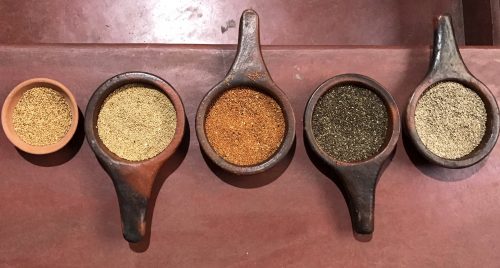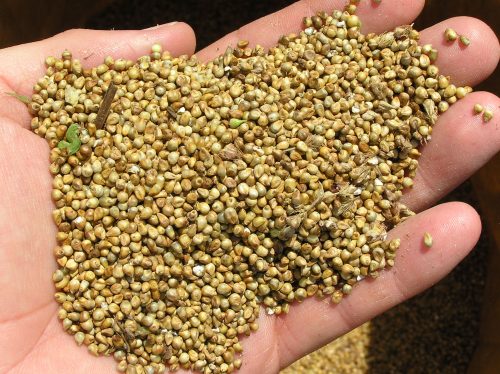TBI Blogs: Here’s How 13 Half-Marathons Hope to Bring Millets Back into Indian Diets
The Mera Terah Run hopes to encourage millet consumption by spreading awareness about its many benefits.

The Mera Terah Run hopes to encourage millet consumption by spreading awareness about its many benefits.
As the mist lifted on the morning of December 15th and most of Bangalore stretched itself awake, 24 people were already well into their day. They are part of the Mera Terah Run (MTR), a collective that builds awareness and raises funds for social causes through half-marathons on 13 consecutive days in areas of relevance.
Its third edition – titled ‘Miles for Millets’ – is dedicated to reviving millets, which are steadily losing their position in Indian diets and giving way to resource-intensive crops. The campaign will make its way through Karnataka, Telangana, Maharashtra, Madhya Pradesh, Chhattisgarh, and Andhra Pradesh over 13 days, meeting and interacting with local communities to raise awareness about millet consumption.
“Millets are disappearing from Indian diets, and so is knowledge about their benefits,” informs Dwijendranath (Dwiji) Guru, expert in sustainable agriculture, ardent millet revivalist, and advisor to the MTR team about the cause of MTR 2016. “Promoting millets through a running program was a natural choice since good nutrition and adequate exercise are essential for good health,” he adds. The organisers of the run, led by Jagadish Damania, wished to raise awareness about millets as a superfood.
Runners will, across the 13 days, eat millets and address local communities about their value.

The main goal of MTR is to promote millets as an aspirational food not just in large metros like Bangalore, but also in smaller towns and villages, where they are losing out to rice paddy and wheat-based food. It will focus on the ecological, economic, and nutritional benefits of millets. Millets are very hardy crops that grow even in extreme conditions with little or no inputs, and are known to be the last-standing crops in case of drought. Thus, their revival and promotion in the Indian diet is key to achieving a sustainable food system. Traditionally, millets were grown and eaten by communities across India, but with the paddy and wheat becoming aspirational foods, millets are being marginalised, and farmers growing them are seeing low returns.
Unpolished millets are nutritional powerhouses, packed with an array of nutrients. The run plans to use millets as a gateway to address larger questions around our food systems and seek sustainable alternatives. It will also touch upon how to identify different millets and the benefits of picking unpolished over polished ones.
The runners will traverse places in South and Central India that have a history of using millets, grow and process millets, and have local entities working to promote their production and consumption. The route is not limited to places where there is already large-scale production and consumption of good quality millets, but also includes smaller towns and villages where millets are yet to make inroads.
For example, millets were a big part of traditional diets in Jabalpur and Raipur, but they are now restricted to Adivasi communities, where they are losing ground quickly.

MTR has partnered with local social enterprises and NGOs working at the community level in 13 cities and nearby towns and villages to promote millet cultivation, processing, and consumption. Through its on-ground partners, the team plans to organise millet promotion events and try to address a diverse audience ranging from farmers, agro-processors, and media to runners’ clubs, athletes, and civil society groups.
Dwiji explains that making millets aspirational is mainly a demand-side issue. “We want to go out into different communities, talk to people about millets as a superfood, and create demand for them. The runners will demonstrate that they eat millets, discuss their numerous benefits, and promote them,” he says.
There is already a sufficient supply of millets, but the right kind of nutrient-rich millets (closer to their natural form) need to be promoted, not those that are just carbohydrate-rich and extracted of their nutrients. The hope is that as people begin to ask for and buy good quality millets, the supply side will catch up.
Also on the agenda is the promotion of decentralised millet processing, and spreading awareness about it in places like Maharashtra, Madhya Pradesh, and Chattisgarh, where little mechanised processing of millets is done. Locally processing millets allows producers to earn more from their sale.
Outside the southern states, millets are mostly processed domestically, or unprocessed millets are exported out of the local areas to bigger centres where they are processed and polished and lose their nutrition.

The team’s efforts do not end with the culmination of the 13-day run. Members will continue supporting the efforts of their local partner organisations in their work with millet promotion even after the MTR. For this purpose, they have developed a training manual – with support from Dhan Foundation – which will be available as a free, downloadable audio-visual file online to partner organisations and to the wider public. Members are also building a network of individuals and organisations interested in millets and millet processing to expand the scope and impact of their work.
Download the millet booklet here, and read more about the Miles for Millets campaign here. Visit Eartha for more stories and videos on environment and sustainable living.
Like this story? Or have something to share? Write to us: [email protected], or connect with us on Facebook and Twitter.
NEW: Click here to get positive news on WhatsApp!
If you found our stories insightful, informative, or even just enjoyable, we invite you to consider making a voluntary payment to support the work we do at The Better India. Your contribution helps us continue producing quality content that educates, inspires, and drives positive change.
Choose one of the payment options below for your contribution-
By paying for the stories you value, you directly contribute to sustaining our efforts focused on making a difference in the world. Together, let's ensure that impactful stories continue to be told and shared, enriching lives and communities alike.
Thank you for your support. Here are some frequently asked questions you might find helpful to know why you are contributing?


This story made me
-
97
-
121
-
89
-
167














